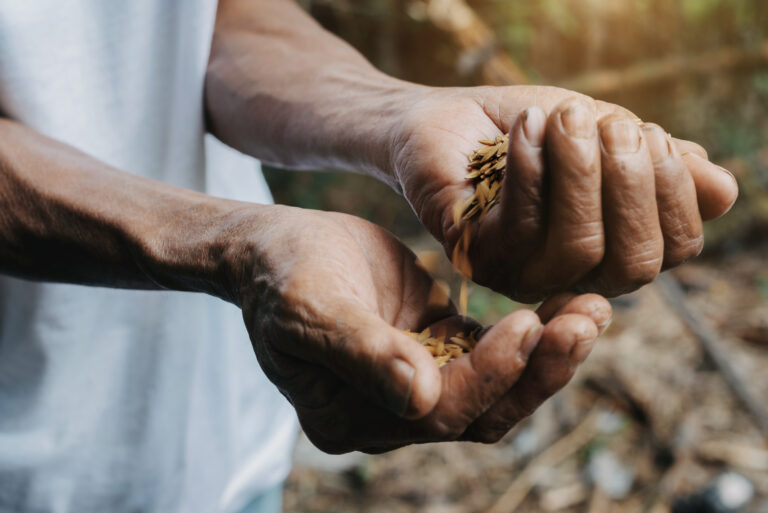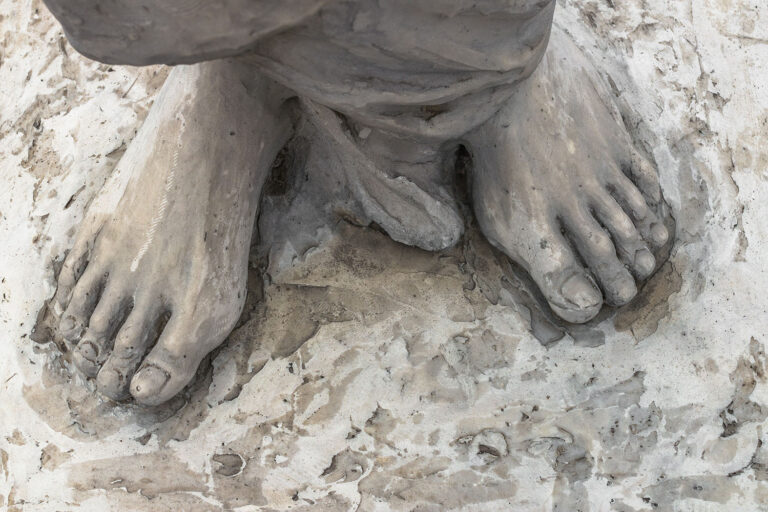Of Sheep and Vocation
It was a Saturday in mid-June of 1979 when all the new seminarians reported to the high school seminary of Colegio de Sto. Tomas-Recoletos in San Carlos City, Negros Occidental.
I could still recall with amusement how parents would accompany their young boys to the seminary. Some of the parents carried large luggage that had seen better days. Others got new ones. Still a few other parents brought in their sons’ clothes, literally in a rough fiber sack, while the pillows, linens, and mosquito nets were neatly rolled up or folded in a native mat. But whether they were rich or poor parents, still the common denominator was a teary-eyed “goodbye.” Some mothers were quite discreet in holding back their tears, while the others cried more copiously and unabashedly, like that day were their last time to see their sons.
In my case, entering the seminary lacked all the trimmings of a drama. How I envied those copious tears and parting hugs of other parents. It was my unexpressive father who accompanied me to the seminary. He never shed a teardrop, and I never heard a cracking voice in his throat either. Not even a parting word.

Life was simpler back then, and simpler still was the mode of transportation. Think of those ubiquitous pedal-driven tricycles and their intermittent honks bellowing from rubber horns—pressed or squeezed, from time to time, to say, “hello,” “hey!” or “goodbye.” What an impressively quiet and peaceful city it was!
My new home.
After putting my things inside the dormitory, I joined the other seminarians in midday prayer at the chapel on the second floor, and later I proceeded, still together with them, to take lunch for the first time inside the seminary. I could still imagine the pleasant smell of chicken noodle soup, something that my palate got to taste for the very first time in my life. Oh, how I loved to be here.
The Prefect of Discipline, the tall but cool Spanish priest, Fr. Juan Garde, OAR, told all of us, seminarians, to take our siesta. I never knew what siesta was. It was my first time to learn that it meant taking a noontime nap, because in our vernacular, it referred only to a guitar!
After siesta and a little wash-up, I went down to the study hall on the second floor of the seminary building where we would have our orientation. The senior seminarians ushered us to what would then be our permanent individual tables and chairs for study. To facilitate identification, a Filipino priest started arranging the tables and chairs for us in rows of five tables from side to side, and about ten tables each vertically, up to the portion where wooden cabinets stood—the ones containing old spiritual books side by side with Zane Grey’s The Hardy Boys. All in all, the tables and chairs could accommodate a maximum number of forty seminarians. Table and chair assignment was done according to our surnames in an alphabetical order. If I looked at the study hall, it was so organized, so orderly, that it was easy for me to memorize the names of my classmates then, just by the location of their tables. It turned out that the Filipino priest who arranged things for us was the seminary rector of the high school seminary in the person of Fr. Rafael Cabarles, OAR. He was our high school seminary rector in the first half of that academic year of 1979-80, before he got transferred to what was then Colegio de San Jose-Recoletos in Cebu City in that same year.
After giving us an orientation talk about seminary life, he quickly stood up and handed us some books with the instructions that all these reading materials had been previously marked or numbered, and that we were all responsible for them—for their safekeeping, or for their loss. Each one of us would receive a copy of the prayer book, student manual, songbook, the Kyriale, and, yes, that nostalgic mimeographed Latin textbook. Remember insula, insulae, insulae…? Many of us who finished high school seminary never got past the third declension. But Latin was fun, anyway. Back in high school seminary, I heard it often said that Latin was a dead language. So, I got to accept it as it was—just that, a dead language that was used only very formally and officially in the Vatican, until a neophyte insisted, like it was an established fact, that not only was it a dead language, but that it was also the language of the dead, and he was rather vigorous in defending his stand—his reason being that he would normally hear Latin hymns sung at funerals in his parish!
Then, we had some free time that afternoon. We all went to the city to buy our needed toiletries and school supplies. Three or four of us entered a small store called, New Cyma Bazaar, and we were amused to hear for the very first time that peculiarly Hiligaynon accent of the three old salesladies. Upon return, we went straight to the dormitory and started lining up our wardrobe with either the thicker wax paper, or the thinner kind of wall paper, before putting in our piles of clothes. After that, we went down to the study hall to cover all our books—the student manual, the prayer book, the song book, the Kyriale, and our Latin textbook—with a transparent plastic cover. Having done all that, we were then ready for school and classes.
But, wait, it was already a quarter of five in the afternoon, and we went downstairs to see the football field. In the small eyes of a young boy of twelve like me, the seminary football field looked daunting, as it appeared like it was the largest and the most spacious sports arena ever in my young world.

During summer, the seminary football field also served as a camping ground for those regular high school students, non-seminarians, who were undergoing their advanced military training—for those who wanted to become officers in the Citizens Army Training or CAT, for the incoming academic year. We did not know—that Saturday itself was already their last day of training. But we got fascinated, nonetheless, by the military tents spread along the right side of the field. There was one big tent, though, that stood out from among the entire row of military tents. Three of us young seminarians peeped inside and saw a man in his forties sitting inside the tent. Upon seeing us, seminarians clad in shorts and sneakers, he went out of his tent and we found out, to our surprise, he was the priest who had arranged the tables and chairs in the study hall earlier on in the afternoon. He was the seminary rector. Come on. We wanted to run. Then, he asked us,
“Do you want to go camping?”
“Yes, Father,” the three of us answered in unison.
“Do you all want to sleep here tonight?”
Again, we said, “yes,” in unison.
“But before you can do that, you will have to answer this question: what is a noun?”
We were all caught flat-footed and dumbfounded, and, in an instant, I remembered I had a handy pocket-size English grammar booklet upstairs which I placed in my study table drawer, so in behalf of the two of my companions, I said, “we don’t know what a noun is, but I can check my English grammar booklet upstairs.”
Amused, Father Cabarles, the seminary rector, told us to go and look for the answer. We just had to be sure we got it right.
About twenty minutes after, the three of us came back to the tent, and told our seminary rector that a noun was a name of any person, place, or thing, and that it was the subject of any given sentence.
He nodded in affirmation,
“Very good. That is the kind of seminarians I want. Study your English well. Study Latin, too.”
“So, could we sleep in the tent tonight?” I innocently asked.
The seminary rector said, “no, I was just joking. Go back to the dorm.”
A little frustrated, we slowly turned our back—chuckling in sheer boyish embarrassment. “Were we not deceived?” We asked ourselves and laughed. We walked a little farther—this time, slower.
We were now getting nearer the seminary building, and, from time to time, we would still turn our heads to look back at those military tents that looked like tiny settlements of some Arab wanderers of old.
A flock of sheep was grazing serenely in the foreground, slowly hindering our sight from those military tents.
Ah, the flock of sheep…
Honestly, I passed the entrance examinations of two high school seminaries.
The first one was the Pope John XXIII High School Seminary at Mabolo, Cebu City. At that time, I did not know they had a new chapel. I saw only the old one—decrepit, abandoned, dusty, and dirty. I did not quite like the place.
I chose Colegio de Sto. Tomas–Recoletos High School Seminary in San Carlos City, Negros Occidental, because there I saw a chapel which was beautiful, solemn, spacious, clean, and well-maintained. Facing the altar, I saw a big crucifix that looked like it was suspended in the air, standing prominently against the backdrop of dark brown stones spread all over the modern retablo, and the face of the crucified Jesus was like speaking to me. I belonged here.
Never did I imagine that I would be spending the next four hard and painful years of my young life in this chapel as a sacristan. As a sacristan, I would be wakened up rather forcefully at four o’clock in the morning almost every day—when most of the boys my age enjoyed their sleep and dreams.
An old priest would come to supervise the cleanliness of the chapel: “wipe the pews, and mop the floor, before you would prepare the vestments, the Roman Missal, the lectionary, the ciborium, the chalice, and the cruets for water and Mass wine.” Only heaven knew, how much dust I would breathe in and how much hard phlegm I had to expunge—with coagulated dust in my phlegm—every time I would gather all that dust on the floor using an improvised mop—how I hated that sackcloth made of abaca hemp, which was greased with used diesel fuel—so pungent and repugnant to my senses—to make the dust stick to it! It was not the mopping up that was difficult. It was the shaking of the dust off that mop that got me gasping for breath.
But there was one thing more that made me chose Sto. Tomas High School Seminary. This might sound funny, if not downright ridiculous—but as a young boy I was always enchanted by the sight of a flock of sheep in the field.
In my childhood, I would always equate a flock of sheep with holy places and sacred events. As we would kneel for our family rosary back home, I would always stare at the family altar and enjoyed the sight of that laminated poster of Our Lady of Fatima appearing to the children, with a flock of sheep spread out in the background.
When we had our early childhood schooling at what was then Consolatrix Academy, run by Augustinian Recollect Sisters, in Toledo City, we would play tag and we would run as fast and as far as possible, out there in the open field, to the point of reaching where three or four sheep were grazing. In class, we had an impromptu Christmas program, and I volunteered and insisted I should be a sheep, so I could get close to Jesus and Mary.
So, there I was in the seminary of my choice…close to the sheep…close to Jesus and Mary!







